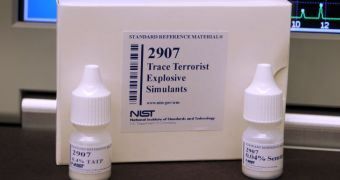The residues left behind after handling explosive such as PETN (pentaerythritol tetranitrate) and TATP (triacetone triperoxide), which are commonly used by terrorists, are the target of a new standard reference material (SRM) developed at the US National Institutes of Standards and Technology (NIST).
While the new material cannot be used as a stand-alone detector for these dangerous chemicals, it will undoubtedly help government agencies, university researchers, and instrument developers in testing, refining and validating new technologies and designs aimed at this purpose.
The new SRM is made up of “inert particles coated with a trace amount of the two explosives,” NIST experts say, which means that it poses no danger of explosion. However, developers can use it to test the efficiency of their new detectors.
The amount of explosives in the reference material is comparable to the one that the future detectors will have to discover in the field.

 14 DAY TRIAL //
14 DAY TRIAL //